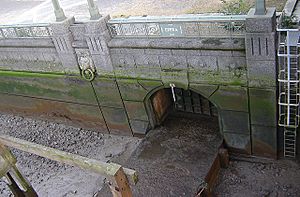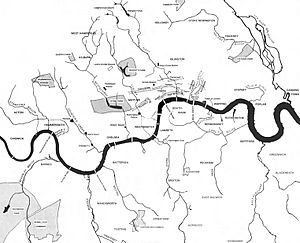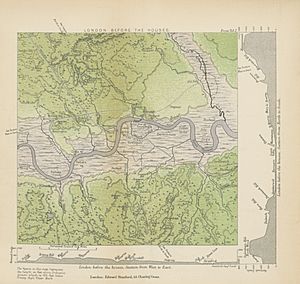Subterranean rivers of London facts for kids

Imagine rivers flowing right under your feet! The underground rivers of London are streams and rivers that once flowed openly into the big Thames river. As the city of London grew bigger and bigger, these rivers were slowly covered up and built over. Now, they mostly flow through special tunnels called culverts. Some of them have even become part of London's huge sewerage system, helping to carry away wastewater.
Contents
Why Rivers Went Underground
Long ago, London was much smaller, and many rivers and streams flowed freely through the land. These smaller rivers were like "tributaries," meaning they fed into the larger River Thames. As more and more people moved to London, the city needed more space for houses, roads, and buildings.
Building Over the Water
It became easier to build over these rivers rather than around them. People started putting the rivers into underground pipes and tunnels. This helped to create more land for building. It also helped with sanitation, as open rivers in a growing city could become dirty and smelly. So, over hundreds of years, many of London's natural waterways disappeared from sight, flowing hidden beneath the streets and buildings we see today.
Rivers North of the Thames
Many hidden rivers flow from the northern parts of London towards the Thames. Here are some of them, listed from west to east:
- River Brent (partially underground)
- Stamford Brook
- Parrs Ditch
- Counter's Creek
- River Westbourne
- River Tyburn
- River Fleet (This one follows the path of roads like Farringdon Street and New Bridge Street.)
- Lamb's Conduit
- Fagswell Brook (This brook follows the path of Charterhouse Street.)
- River Walbrook
- Lorteburn or Langbourne (This river is now completely dry.)
- Black Ditch
- Muswell Stream (This stream flows into Pymmes Brook, which then joins the River Lea.)
- River Moselle (This river also flows into the Lea.)
- Hackney Brook (Another river that flows into the Lea.)
- River Rom (partially underground)
Rivers South of the Thames
On the south side of the Thames, there are also many rivers that have been covered up. Here are some of them, listed from west to east:
- Sudbrook (partially underground)
- Beverley Brook (partially underground)
- Graveney (This river is a smaller part of the River Wandle.)
- Falconbrook
- River Effra
- River Neckinger
- Earl's Sluice
- River Peck
- River Quaggy (partially underground) (This river flows into the River Ravensbourne.)
- Heathwall Ditch
Bringing Rivers Back to Life
In recent years, people have started thinking about bringing some of these hidden rivers back to the surface. This idea is called "daylighting" a stream. It means uncovering the river from its underground pipes and letting it flow openly again.
Plans for the Future
In June 2008, the office of the Mayor of London shared some early ideas about uncovering certain underground rivers. Then, in January 2009, several important groups like the Environment Agency, Natural England, The River Restoration Centre, and the Greater London Authority teamed up. They created a plan called the London Rivers Action Plan. This plan aims to find ways to bring some of London's lost rivers back into the daylight, making the city greener and healthier.
Images for kids
-
The hidden mouth of the Earl's Sluice river at Deptford Wharf.




